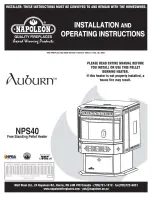
Combustion
air
Combustion
air
6
9
1.9 Draft conditions
and the chimney
Poor draft will not allow the stove to burn, as it
should. The glass can soot, requires cleaning of
the chimney more often, smoke can escape out
when the door is open and it gives poor fuel ef-
ficiency. Leading to unnecessary polluting of the
environment.
Good draft will allow the stove to achieve op-
timal combustion and the highest possible ef-
ficiency. Heta wood stoves are constructed so
that it itself provides an optimal blend of com-
bustion air. This provides a high efficiency/heat,
clean glass and low environmental impact.
Minimum chimney draft for Prestige insert is 10
PA. It is the draft that the stove has been tested
and approved on. The minimum draft is neces-
sary to provide clean burning, beautiful flame
picture, as well as achieving the rated efficiency.
There is a risk of smoke escaping into the room
if the door is opened during vigorous firing, or if
there is a lack of air supply to the room, for ex. if
an extraction fan is in use.
Flue gas temperature at the rated output is 312°C
relative to 20°C. Flue gas flow is 6,3 g / sec.
The chimney height and diameter, as well as
the temperature difference between the flue gas
and outside temperature generates the chimney
draft. Chimney insulation is therefore important
as new efficient stoves create lower flue tempe-
ratures. Wind and weather conditions also in-
fluence draft, in some cases it may be disad-
vantageous wind direction, combined with the
position of the chimney can cause negative draft
(it blows through the chimney), causing smoke
escape from the stove.
Before using after a long period of inactivity,
check that the chimney is free for any blocka-
ges. (soot build-up, bird nests, leaves etc.).
Reduced draft can occur when:
• The tem
perature difference is too small
between smoke gasses and outdoor
• To short of a chimney
• The outside temperature is high, and indoor
temperature is low f. ex. in summer
• False air in the chimney
• Chimney is blocked
• Air tight house (lack of combustion air supply)
• Poorly placed chimney for the surroundings,
for ex. the ridge and trees may cause
turbulence.
Good draft occurs when:
• Th
e difference in temperature in the chimney
(warmer) and outside temperature (colder)
• It is clear weather
• The chimney has the right height min 4 meters
above the stove, and clear of the roof ridge
1.10 fuel
Your new stove is EN approved for firing with
wood fuel. You must therefore only burn clean,
dry wood in your stove. Never use your stove
to burn driftwood, as this may contain a lot of
salt which can damage both the stove and the
chimney. Similarly, you must not fire your stove
with refuse, painted wood, pressure-impregna-
ted wood or chipboard, as these materials can
emit poisonous fumes and smoke.
Correct firing using well seasoned wood pro-
vides optimal heat output and maximum effi-
ciency. At the same time, correct firing prevents
environmental damage in the form of smoke
emissions and reduces the risk of chimney fires.
If the wood is damp and inadequately seasoned,
a large proportion of the energy in the fuel will
be used to vaporize the water, and this will all
disappear up the chimney. Thus, it is important
to use dry, well seasoned wood, i.e. wood with a
moisture content of less than 20 %. Achieve this
by storing the wood for 1–2 years before use.
Pieces of firewood with a diameter of more than
10 cm should be split before before storing. The
pieces of firewood should be of an appropriate
length (approx. 19-25 cm) so that they can lie
flat on the bed of embers.
If you store your wood outdoors, it is best to
cover it.
Summary of Contents for SCAN-LINE SOLID C
Page 2: ...2...
Page 26: ...4 5 6 26 5 x M4x8 4 Connecting external air supply from below 2 x4 1 3 x4...
Page 27: ...7 8 27 x4 2 1 x3 x3 90o 3 x3 5 Connecting external air supply from behind...
Page 28: ...28...
Page 29: ...29...
Page 30: ...30...
Page 32: ...32...










































